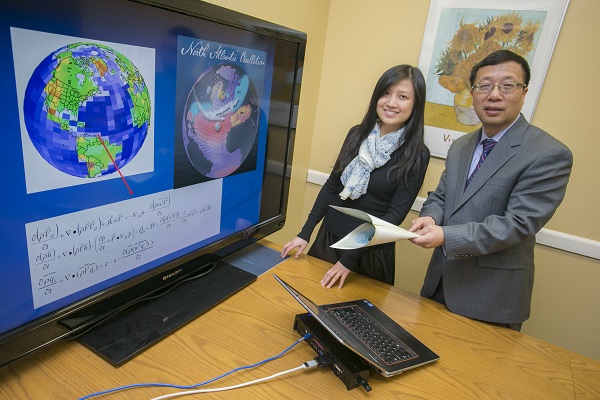Findings published in Nature Geoscience also indicate a way to make more accurate predictions about future climate trends

Professor Minghua Zhang, right, and graduate student Tingyin Xiao, discovered that industrial emissions of aerosols over the last 100 years dramatically changed the atmospheric asymmetry between the North Atlantic and South Atlantic and thus the relationship between temperature and precipitation in the northern tropics.
Stony Brook, NY, February 9, 2015 – An international team of scientists, including Minghua Zhang, Dean and Director of Stony Brook University’s School of Marine and Atmospheric Sciences (SoMAS), has found that man-made aerosol emissions from industrial processes have changed the relationship between temperature and precipitation in the northing tropics. The findings, published early online in Nature Geoscience, may help to indicate the shifts in seasonal rainfall in Central America, which is critical for agriculture in the region.
The team reconstructed rainfall patterns and temperature over 450 years by analyzing the chemical composition of a stalagmite recovered from a cave in Belize in Central America. Stalagmite in the cave was formed through deposition of calcium carbonate and other minerals, which precipitated from mineralized water solutions. These water solutions contain oxygen and carbon. The team used the oxygen and carbon isotopic ratios from each layer of stalagmite deposits to recover the cumulative signals of climatic and hydrogeological variations over the past 450 years that include rainfall and temperature. Because of the unique seasonal variation of precipitation in Belize, the researchers were able to accurately date the layers of deposits.
Professor Zhang and Tingyin Xiao, a Stony Brook SoMAS graduate student, conducted research that found out-of-phase relationships between temperature and rainfall within the last 100 years in the northern tropics that is contrary to how the atmospheric dynamical system is expected to work. The stalagmite analysis indicated a shift in the relationship between temperature and rainfall after the industrial revolution. The team then explained that aerosols from industrial emissions have changed the hemispheric contrast of radiative energy between the northern tropics and southern tropics that shifted the relationship between temperature and rainfall.
“We found an unexpected relationship between temperature and rainfall in the northern tropics with a systemic trend of decreasing rainfall,” said Professor Zhang. “This corroborated with what the entire research team found over a much longer period of time based on the cave data.”
Lead author, Dr. Harriet Ridley, from the Department of Earth Sciences at Durham University in the United Kingdom, which led the study, added “The research presents strong evidence that industrial sulphate emissions have shifted this important rainfall belt, particularly over the last 100 years.”
In the paper, titled “Aerosol forcing of the position of the intertropical convergence zone since AD 1550,” the researchers also identified a substantial drying trend from 1850 onwards, coinciding with a steady rise in sulphate aerosols building in the atmosphere as a result of burning fossil fuels during the European and American Industrial Revolution.
Professor Zhang explained that sulphate aerosols from emissions moderated temperatures in the Northern Hemisphere by reflecting the Sun’s radiation. This resulted in the Intertropical Convergence Zone – a tropical rainfall belt near the equator – to be shifted toward the warmer Southern Hemisphere, which leads to drier conditions in the northern tropics.
The international research team included scientists from Durham University, Stony Brook University, the University of New Mexico, Pennsylvania State University, Northern Arizona University, ETH Zurich, and the Potsdam Institute for Climate Impact Research.
The work was funded in part by the National Science Foundation.
Reporter Contact: Gregory Filiano, Stony Brook Medicine Media Relations Manager, 631-444-9343




You must be logged in to post a comment.